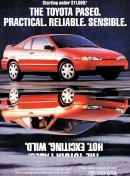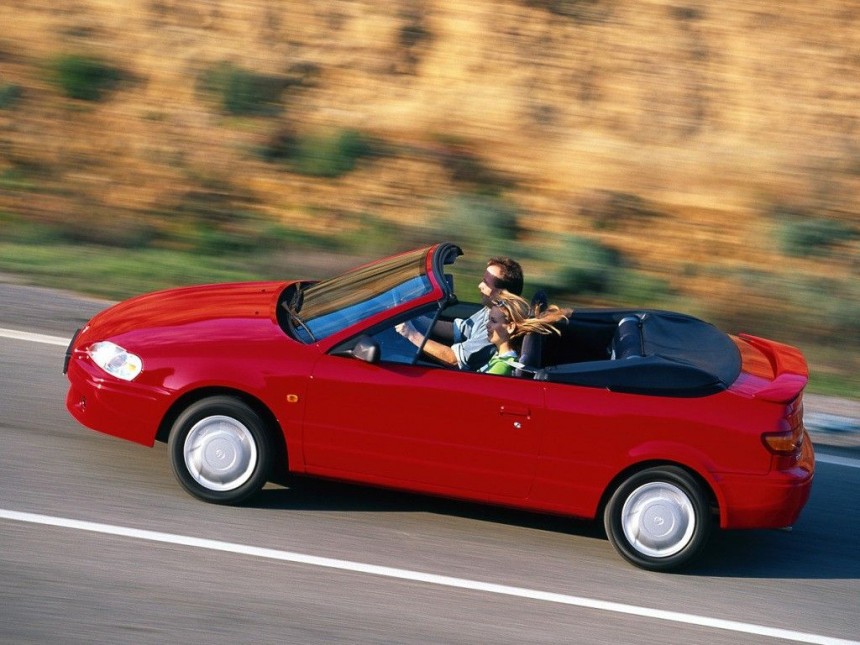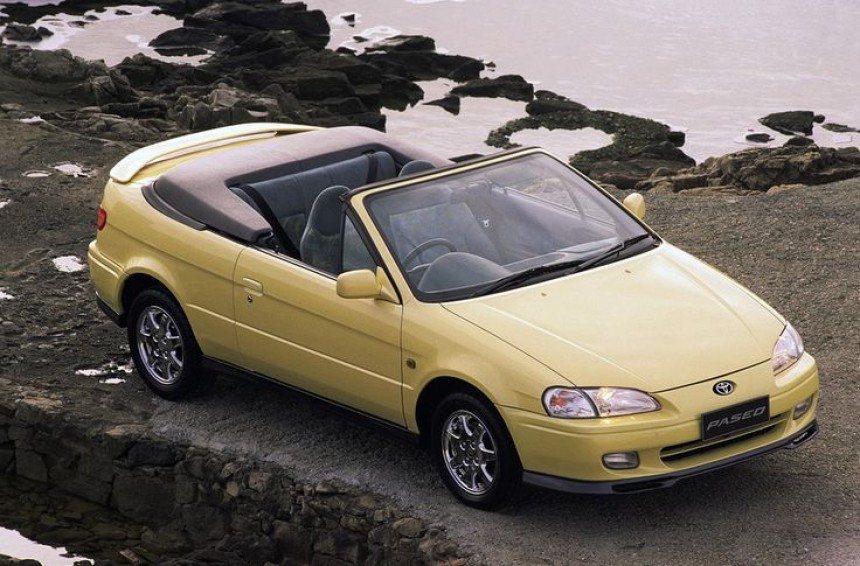The Toyota Paseo is a sports car. You wouldn't figure that with just a passing glance, nor would you believe it if you saw the spec sheet. But Brian of Regular Car Reviews (RCR) took one for a spin some time ago and proved it before our very eyes. But what better way to make a sports car better than by taking the top down?
The Paseo Convertible, especially in its USDM second-generation form, is a car that's hardly remembered even by 90s JDM enthusiasts. Perpetually overshadowed by the Supra, Celica, and even the Tercel it shares a platform with, the Paseo is even more of a pariah in convertible form than it is as a 2+2 coupe. But as RCR so eloquently pointed out, the Paseo is worth at least a little bit more than the sum of its parts.
For those who aren't familiar with the bare basics, the first-generation Paseo rolled off Toyota factory floors from January 1991 until August 1995. The second generation that gifted us with the convertible began its run in 1996. At that time, the car came with the lauded 5E-FE-series engine that was one of the very last in a line of bulletproof, non-variable valve timing-equipped Toyota four-pots that will probably outlast all of us.
It was paired with a dismal four-speed automatic transmission or a five-speed manual if you were lucky. This gearbox sent power to the front wheels only, not that the 93 or so horsepower on tap were going to cause torque steer problems. It's good for 0-60 mph times in a pedestrian range of 11.4-seconds and a quarter-mile time of 18.4 seconds, according to old Motorweek test footage. Sure, the Tercel-derived underpinnings and drivetrain may not have sounded like a recipe for anything other than failure.
But as Brian from RCR will tell you, the Paseo manages to be more fun to drive in normal speed limit conditions than a modern 300-horsepower GR Corolla could ever be. Without side impact airbags or any modern safety features demanded on modern cars, virtues of this nature are indeed possible. In Japan, under the Toyota Cynos moniker, the second generation of the platform received an upgraded variant of the 5E-FE engine dubbed the 5E-FHE.
It cranked out a full ten horsepower more over its USDM-spec model. So then, the JDM market being greedy with the best of their engine tech, no surprises there. In fairness, there was a smaller 1.3 L 4E-FE four-pot available in Japan as well. With its second-generation facelift, the Paseo went all out in making itself look strikingly similar to other Toyota sports cars in the lineup. They don't call it the "baby Celica" for nothing.
From there, a manually operated latching canvas top is laid over the body to follow the exact body lines of the equivalent Paseo Coupe. Though it must be said, magazine test drivers of the period did complain about water leak issues in heavy rainfall and a tad less rear visibility than they would have hoped for with the Paseo Convertible in particular. As for the interior, it's pretty standard Toyota fare.
Toyota interiors in the mid to late 90s were never known for their flair or quality of materials. Even so, it's still utilitarian and durable in a way that only 90s JDM imports could be. The Paseo Convertible's front bucket seats were said to have felt more supportive than the average sub-compact economy car's seats of the same timeframe. They also had the option of being decked out in funky patterns that scream the 1990s more than an MTV T-shirt could.
We can only surmise that the stationary paper-white speedometer, tach, and fuel/temp gauges must have gotten pretty porting after a couple hundred thousand miles. But you don't see too many domestic interiors from the 90s that look any better or are nearly as durable.
The rear seats in this tiny drop-top might only be sufficient for a cat or a terrier, but with 6.6 cubic feet of cargo room in the trunk, Toyota must have known the bachelor or bachelorette who bought this car brand new had priorities other than accommodating a baby's cradle.
The advent of the Honda Prelude rendered the Toyota Paseo all but defenseless in terms of sales and appeal. This was the main impetus behind the sunsetting of the Paseo line in 1997 in the US. But even so, if you need a drop-top convertible this summer and don't want to spend the king's share to do it, a net value of $1,118 to $1,749 on Edmunds makes this Toyota a steal so long as the seller isn't highballing you.
Check back soon for more from Open Top Month coverage here on autoevolution, and check out RCR Brian's review of a first gen Paseo below if you want to learn more. Be warned though, it has some very non PG humor.
For those who aren't familiar with the bare basics, the first-generation Paseo rolled off Toyota factory floors from January 1991 until August 1995. The second generation that gifted us with the convertible began its run in 1996. At that time, the car came with the lauded 5E-FE-series engine that was one of the very last in a line of bulletproof, non-variable valve timing-equipped Toyota four-pots that will probably outlast all of us.
It was paired with a dismal four-speed automatic transmission or a five-speed manual if you were lucky. This gearbox sent power to the front wheels only, not that the 93 or so horsepower on tap were going to cause torque steer problems. It's good for 0-60 mph times in a pedestrian range of 11.4-seconds and a quarter-mile time of 18.4 seconds, according to old Motorweek test footage. Sure, the Tercel-derived underpinnings and drivetrain may not have sounded like a recipe for anything other than failure.
But as Brian from RCR will tell you, the Paseo manages to be more fun to drive in normal speed limit conditions than a modern 300-horsepower GR Corolla could ever be. Without side impact airbags or any modern safety features demanded on modern cars, virtues of this nature are indeed possible. In Japan, under the Toyota Cynos moniker, the second generation of the platform received an upgraded variant of the 5E-FE engine dubbed the 5E-FHE.
From there, a manually operated latching canvas top is laid over the body to follow the exact body lines of the equivalent Paseo Coupe. Though it must be said, magazine test drivers of the period did complain about water leak issues in heavy rainfall and a tad less rear visibility than they would have hoped for with the Paseo Convertible in particular. As for the interior, it's pretty standard Toyota fare.
Toyota interiors in the mid to late 90s were never known for their flair or quality of materials. Even so, it's still utilitarian and durable in a way that only 90s JDM imports could be. The Paseo Convertible's front bucket seats were said to have felt more supportive than the average sub-compact economy car's seats of the same timeframe. They also had the option of being decked out in funky patterns that scream the 1990s more than an MTV T-shirt could.
We can only surmise that the stationary paper-white speedometer, tach, and fuel/temp gauges must have gotten pretty porting after a couple hundred thousand miles. But you don't see too many domestic interiors from the 90s that look any better or are nearly as durable.
The advent of the Honda Prelude rendered the Toyota Paseo all but defenseless in terms of sales and appeal. This was the main impetus behind the sunsetting of the Paseo line in 1997 in the US. But even so, if you need a drop-top convertible this summer and don't want to spend the king's share to do it, a net value of $1,118 to $1,749 on Edmunds makes this Toyota a steal so long as the seller isn't highballing you.
Check back soon for more from Open Top Month coverage here on autoevolution, and check out RCR Brian's review of a first gen Paseo below if you want to learn more. Be warned though, it has some very non PG humor.













